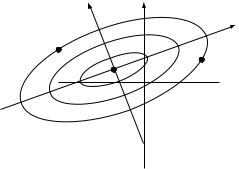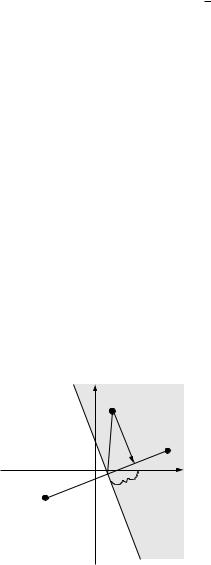
Fundamentals Of Wireless Communication
.pdf


500 |
Appendix A Detection and estimation in additive Gaussian noise |
combinations of the others. To avoid messy notation, we can focus only on those components of Aw that are linearly independent and represent them as a lower dimensional vector x˜, and represent the other components of Aw as (deterministic) linear combinations of the components of x˜. By this strategem, we can always take the covariance K to be invertible.
In general, a Gaussian random vector is completely characterized by its mean and by the covariance matrix K; we denote the random vector by
K .
A.1.3 Complex Gaussian random vectors
So far we have considered real random vectors. In this book, we are primarily interested in complex random vectors; these are of the form x = xR + jxI where xR xI are real random vectors. Complex Gaussian random vectors are ones in which xR xI t is a real Gaussian random vector. The distribution is completely specified by the mean and covariance matrix of the real vectorxR xI t. Exercise A.3 shows that the same information is contained in the mean , the covariance matrix K, and the pseudo-covariance matrix J of the complex vector x, where
= x |
(A.14) |
K = x − x − |
(A.15) |
J = x − x − t |
(A.16) |
Here, A is the transpose of the matrix A with each element replaced by its complex conjugate, and At is just the transpose of A. Note that in general the covariance matrix K of the complex random vector x by itself is not enough to specify the full second-order statistics of x. Indeed, since K is Hermitian, i.e., K = K , the diagonal elements are real and the elements in the lower and upper triangles are complex conjugates of each other. Hence it is specified by n2 real parameters, where n is the (complex) dimension of x. On the other hand, the full second-order statistics of x are specified by the n2n + 1 real parameters in the symmetric 2n × 2n covariance matrix of xR xI t.
For reasons explained in Chapter 2, in wireless communication we are almost exclusively interested in complex random vectors that have the circular symmetry property:
x is circular symmetric if ej x has the same distribution of x for any
(A.17)
For a circular symmetric complex random vector x,
x = ej x = ej x |
(A.18) |

501 |
A.1 Gaussian random variables |
for any ; hence the mean = 0. Moreover
xxt = ej x ej x t = ej2 xxt |
(A.19) |
for any ; hence the pseudo-covariance matrix J is also zero. Thus, the covariance matrix K fully specifies the firstand second-order statistics of a circular symmetric random vector. And if the complex random vector is also Gaussian, K in fact specifies its entire statistics. A circular symmetric Gaussian random vector with covariance matrix K is denoted as (0,K).
Some special cases:
1.A complex Gaussian random variable w = wR + jwI with i.i.d. zero-mean Gaussian real and imaginary components is circular symmetric. The circu-
lar symmetry of w is in fact a restatement of the rotational invariance of the real Gaussian random vector wR wI t already observed (cf. (A.8)). In fact, a circular symmetric Gaussian random variable must have i.i.d. zero-mean real and imaginary components (Exercise A.5). The statistics are fully specified by the variance 2 = w 2 , and the complex random variable is denoted as 0 2 . (Note that, in contrast, the statistics of a general complex Gaussian random variable are specified by five real parameters: the means and the variances of the real and imaginary components and their correlation.) The phase of w is uniform over the range 0 2 and independent of the magnitude w , which has a density given by
f r |
= |
r |
exp |
−r2 |
|
r |
≥ |
0 |
(A.20) |
|
2 |
2 2 |
|||||||||
|
|
|
|
|
|
and is known as a Rayleigh random variable. The square of the magnitude, i.e., w12 + w22, is '22, i.e., exponentially distributed, cf. (A.9). A random variable distributed as 0 1 is said to be standard, with the real and imaginary parts each having variance 1/2.
2.A collection of n i.i.d. 0 1 random variables forms a standard circular symmetric Gaussian random vector w and is denoted by 0 I . The density function of w can be explicitly written as, following from (A.7),
fw = |
1 |
exp − w 2 w n |
(A.21) |
n |
As in the case of a real Gaussian random vector 0 I (cf. (A.8)), we have the property that
Uw has the same distribution as w |
(A.22) |
|
|
for any complex orthogonal matrix U (such a matrix is called a unitary matrix and is characterized by the property U U = I). The property (A.22) is the complex extension of the isotropic property of the real standard Gaussian random vector (cf. (A.8)). Note the distinction between the circular

502 |
Appendix A Detection and estimation in additive Gaussian noise |
symmetry (A.17) and the isotropic (A.22) properties: the latter is in general much stronger than the former except that they coincide when w is scalar.
The square of the magnitude of w, as in the real case, is a '22n random variable.
3.If w is 0 I and A is a complex matrix, then x = Aw is also circular symmetric Gaussian, with covariance matrix K = AA , i.e., 0 K .
Conversely, any circular symmetric Gaussian random vector with covariance matrix K can be written as a linearly transformed version of a standard circular symmetric random vector. If A is invertible, the density function of x can be explicitly calculated via (A.21), as in (A.12),
fx = |
1 |
−x K−1x x n |
|
n det K exp |
(A.23) |
When A is not invertible, the earlier discussion for real random vectors applies here as well: we focus only on the linearly independent components of x, and treat the other components as deterministic linear combinations of these. This allows us to work with a compact notation.
Summary A.1 Complex Gaussian random vectors
•An n-dimensional complex Gaussian random vector x has real and imaginary components which form a 2n-dimensional real Gaussian random vector.
•x is circular symmetric if for any ,
ej x x |
(A.24) |
•A circular symmetric Gaussian x has zero mean and its statistics are fully specified by the covariance matrix K = xx . It is denoted by
0 K .
•The scalar complex random variable w 0 1 has i.i.d. real and imaginary components each distributed as 0 1/2 . The phase of w is uniformly distributed in 0 2 and independent of its magnitude w , which is Rayleigh distributed:
f r = r exp − r2 r ≥ 0 (A.25) 2
w 2 is exponentially distributed.
•If the random vector w 0 I , then its real and imaginary components are all i.i.d., and w is isotropic, i.e., for any unitary matrix U,
Uw w |
(A.26) |

503 |
A.2 Detection in Gaussian noise |
Equivalently, the projections of w onto orthogonal directions are i.i.d.0 1 . The squared magnitude w 2 is distributed as '22n with mean n.
• If x 0 K and K is invertible, then the density of x is
f x = |
1 |
|
n det K exp −x K−1x x n |
(A.27) |
A.2 Detection in Gaussian noise
A.2.1 Scalar detection
Consider the real additive Gaussian noise channel: |
|
y = u + w |
(A.28) |
where the transmit symbol u is equally likely to be uA or uB |
and w |
0 N0/2 is real Gaussian noise. The detection problem involves making a decision on whether uA or uB was transmitted based on the observation y. The optimal detector, with the least probability of making an erroneous decision, chooses the symbol that is most likely to have been transmitted given the received signal y, i.e., uA is chosen if
u = uA y ≥ u = uB y |
(A.29) |
Since the two symbols uA, uB are equally likely to have been transmitted, Bayes’ rule lets us simplify this to the maximum likelihood (ML) receiver, which chooses the transmit symbol that makes the observation y most likely. Conditioned on u = ui, the received signal y ui N0/2 i = A B, and
the decision rule is to choose uA if |
|
− |
|
|
|
||||
√ N0 |
− |
N0 |
≥ √ N0 |
N0 |
|
||||
1 |
exp |
|
y − uA 2 |
1 |
exp |
|
y − uB 2 |
|
(A.30) |
and uB otherwise. The ML rule in (A.30) further simplifies: choose uA when
y − uA < y − uB |
(A.31) |
The rule is illustrated in Figure A.4 and can be interpreted as corresponding to choosing the nearest neighboring transmit symbol. The probability of making an error, the same whether the symbol uA or uB was transmitted, is equal to
|
y < |
uA + uB |
|
u |
|
u |
|
= |
w > |
|
uA − uB |
|
|
Q |
|
uA − uB |
(A.32) |
||
|
|
|
= |
A |
|
2 |
= |
2 |
|
|
|||||||||
2 |
|
|
|
|
N0/2 |
|
|
||||||||||||
|
|
|
|
|
|
|
|
|
|
|
|
|
|
|
|
|
|
|
|

504 |
Appendix A Detection and estimation in additive Gaussian noise |
|
Figure A.4 The ML rule is to |
|
|
choose the symbol that is |
|
|
closest to the received symbol. |
{y|x = uA} |
{y|x = uB} |
|
||
If y < (uA + uB)/2 |
If y > (uA + uB) / 2 |
choose uA |
choose uB |
y
uA (uA+uB) uB
2
Thus, the error probability only depends on the distance between the two transmit symbols uA uB.
A.2.2 Detection in a vector space
Now consider detecting the transmit vector u equally likely to be uA or uB (both elements of n). The received vector is
y = u + w |
(A.33) |
and w 0 N0/2 I . Analogous to (A.30), the ML decision rule is to choose uA if
|
1 |
exp |
y − uA 2 |
|
1 |
exp |
|
|
y − uB 2 |
(A.34) |
N0 n/2 |
|
≥ N0 n/2 |
− |
|
||||||
− |
N0 |
|
N0 |
|
||||||
which simplifies to, analogous to (A.31), |
|
|
|
|
|
|||||
|
|
|
y − uA < y − uB |
|
|
|
(A.35) |
|||
the same nearest neighbor rule. By the isotropic property of the Gaussian noise, we expect the error probability to be the same for both the transmit symbols uA uB. Suppose uA is transmitted, so y = uA + w. Then an error occurs when the event in (A.35) does not occur, i.e., w > w + uA − uB . So, the error probability is equal to
|
|
|
|
|
+ |
|
A − |
|
B |
|
|
= |
|
A − |
B |
|
− |
2 |
|
|
w |
2 > |
|
w |
|
u |
|
u |
|
2 |
|
|
u |
|
u |
tw < |
|
uA − uB 2 |
(A.36) |
|
|
|
|
|
|
|
|
|
|


507 |
A.2 Detection in Gaussian noise |
This important observation can be summarized:
1.In technical jargon, the scalar y˜ in (A.41) is called a sufficient statistic of the received vector y to detect the transmit symbol u.
2.The sufficient statistic y˜ is a projection of the received signal in the signal direction v: in the literature on communication theory, this operation is called a matched filter; the linear filter at the receiver is “matched” to the direction of the transmit signal.
3.This argument explains why the error probability depends on uA and uB only through the distance between them: the noise is isotropic and the
entire detection problem is rotationally invariant.
We now arrive at a scalar detection problem:
y˜ = x uA − uB + w |
(A.43) |
where w, the first component of Ow is 0 N0/2 and independent of the transmit symbol u. The effective distance between the two constellation points is uA − uB . The error probability is, from (A.32),
|
2 N0/2 |
|
|
Q |
uA − uB |
|
(A.44) |
the same as that arrived at in (A.37), via a direct calculation.
The above argument for binary detection generalizes naturally to the case when the transmit vector can be one of M vectors u1 uM . The projection of y onto the subspace spanned by u1 uM is a sufficient statistic for the detection problem. In the special case when the vectors u1 uM are collinear, i.e., ui = hxi for some vector h (for example, when we are transmitting from a PAM constellation), then a projection onto the direction h provides a sufficient statistic.
A.2.3 Detection in a complex vector space
Consider detecting the transmit symbol u, equally likely to be one of two complex vectors uA uB in additive standard complex Gaussian noise. The received complex vector is
y = u + w |
(A.45) |
||
where w 0 N0I . We can proceed as in the real case. Write |
|
||
1 |
|
|
|
u = xuA − uB + |
|
uA + uB |
(A.46) |
2 |
|||

 a
a a
a y
y